They hang, silent and still, for one to two weeks before the chrysalis darkens and I see wings. The birth (eclosure) takes seconds and I usually miss it, but I caught one last week.
A caterpillar becomes a chrysalis and inside that container of dissolving caterpillar nutrient broth, a Monarch takes shape to emerge as an adult. There’s nothing like it in the mammal world. This one is male.
The butterfly forms head down. When the chrysalis splits, his legs come out first and grab the chrysalis shell. Then he somersaults like a gymnast. That spiral on his head is the proboscis and it unfurls into a straw when he sips nectar, his only food source as a butterfly.
The body and wings unfurl and he hangs on his chrysalis for a few hours while his body and wings extend.
Then he slowly opens and closes his wings to dry them. In four hours or more, he’s ready to visit the butterfly garden and then to fly.
***
By the time this is posted, all the Monarchs will be gone for the season, beginning their 2,500 mile journey to Mexico for the winter. I’ve seen more in my fields this year than I have for decades–and most are not ones I raised. Monarchs are having a good year here. What thrilled your heart this summer? What brought you joy? What part of the natural world are you protecting?
For other posts about Monarchs, see Precious Transformation: Monarchs, Mystery, and Mythology. For a piece about supporting Milkweed growth, the only plants Monarch caterpillars eat, see Seeding the Cycles of Life.
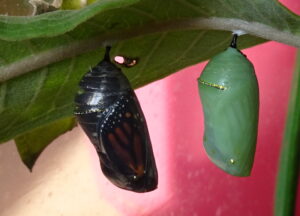

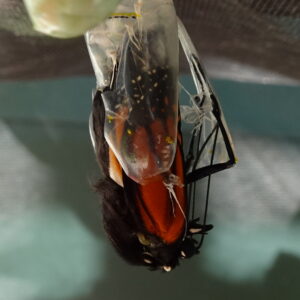
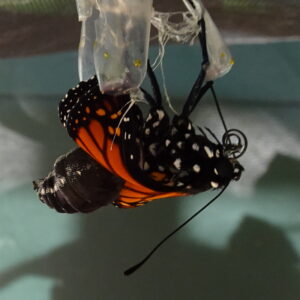


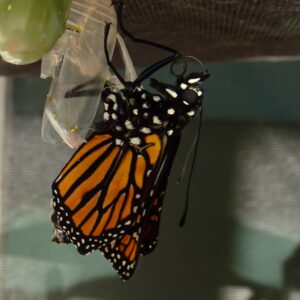

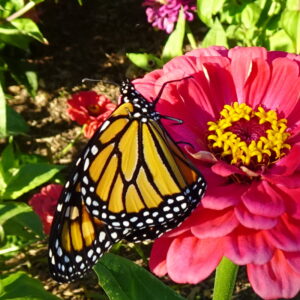
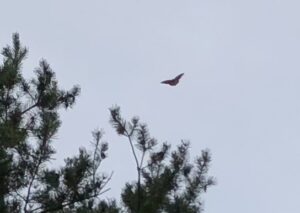
Beautiful! “Somersaulting into Life”, I love your title today! Thank you so much Elaine for sharing this beautiful birth (eclosure) and more gorgeous butterfly photos with us! Oh, I’m curious, how do you know if you’ve raised the Monarchs in your field? Can you recognise your children by sight alone? All butterflies look the same to me unless they’re a bit tatty or newly opened. Wow, what an incredible journey they make to fly to Mexico at the end of summer, start of autumn, arriving in time for the Day of the Dead.
Sadly, as you know most of my summer was spent on the settee recovering from yet another broken ankle or in my writing chair in the garden on dry days. So a very different summer for me, however, it did mean that I was able to write more (and finally join Facebook … I’ll be back soon!) and was particularly thrilled to dedicate “Mama Monarch” to you my lovely friend. In other news, last weekend I walked 3.72 miles so getting back to walking distances again. Sending love and light across the oaks and oceans between us, Deborah.
Deborah, I can’t identify the Monarchs other than if they’re male or female, egg layers or migrators. All were long-winged migrators in the last month and they’ve all now left and sailed a wind south. Last week, walking in the fields on warm days with a strong wind blowing from the south (they need to ride a north or northwest wind), I saw many more Monarchs than I’d released for the last month. Other friends saw many at their places, too. Monarchs did well this year. They had to be migrators passing through from north of me. When the southbound journey is stopped by the wind, they fill up on nectar. My fields had all the flowers they prefer. In the spring and mid summer, some elders are faded and have torn wings. These were all long winged young Monarchs heading south.
Keep recovering from your break and may recovery continue so there is never another break. Walking almost 4 miles is a long distance and a huge achievement, along with the physical exercises to target that ankle and other bones. I keep doing physical therapy. I see her just once a month now, but consider her a coach to keep me going. Progress is slow, but it’s happening and I feel stronger on my two feet. I haven’t broken anything, but know I could if I don’t keep working on balance. I also bought trekking sticks for slippery weather that could arrive here any day.
Love to you, dear healing, loving friend. It’s an honor to be called Mama Monarch.
Just wow! And how do you know the males from females? And do they all go to Mexico or some not as far?
Thank you, Myra. I’m sorry we didn’t get to talk on Sunday but I loved waving across the tent. My hearing is lost in a crowd and especially when I can’t read lips. Male Monarchs have thinner black lines on the wings and an oval of black in the middle of one black wing. It’s easy to spot the difference and here’s a link showing the difference: https://journeynorth.org/tm/monarch/id_male_female.html
All Monarchs from here go to Mexico, south along the western slopes of the Smokies, across into Texas and then to the Biopreserve west of Mexico City. If this migrator makes it, it will live 8-10 months. Millions of Monarchs winter in a small area hanging on oxymel fir trees. Here they want only milkweed. In Mexico they go for oxymel fir for roosting, but don’t eat it. They have specific demands, but I’ve never seen more Monarchs than I did this year. They’re out of here now. I’ll watch for them in late May or early June. Meanwhile, I’ll keep writing about my summers with them (this was the 4th) even though I haven’t shared most of that writing on my blog.
Elaine, this is a phenomenal column. The photos, the explanations, and the somersaulting into life is magical. I am booting up my color printer and going to hold on to a hard copy of this. I so look forward to doing more of this next season. I have milkweed seeds in the frig and will plant them very soon. I am also going to use the water bottle technique I shared with you…There is something sacred about contributing to our earth and butterfly life. Thanks so much for this beautiful piece.
Thank you, Mary. I thought I wouldn’t see an eclosure this summer since it happens so fast and I can’t spend my whole day looking at the dark chrysalis. Only 1/4 – 1/2 my day. 😉 I got lucky. I agree there is something sacred about participating in the Monarch miracle and helping them survive. I look forward to finding out how your milkweed growing experiments go since I’ve never had to plant it. The fields are loaded with milkweed pods this year because of all the rain, so I have seeds to share after a freeze. They’re still ripening now and when the fields are mowed after a hard freeze, the air is filled with flying seeds. I have to make sure to photograph that this year. Sending you love and Monarch blessings.
What a thrilling post Elaine, thank you so much! It’s such a joy to me on many levels to witness from afar your journey with the Monarchs. It brings home to me how we often have to perform somersaults even from birth to withstand the seasons, life, and its capriciousness. Such a delight to see these photos and the amazing birth of the butterfly as it begins it arduous journey to flutter by en route to Mexico.
What was exciting for me happened a few days ago. My son Mike and I went walking in a rather wild area, never before trekked by us. We’d had terrible fires just over four years ago over vast areas and much was destroyed. Here, we saw the natural bush in full growth, bloom and colour, revived from the destruction. Some of the trees still stood, dead, black, in stark reminder yet there was beauty in them.
I’m thrilled, too, Susan–and it shows. Humans also somersault at birth if the mama is squatting or using a birthing chair. I don’t know if the trip to Mexico is arduous for them. It depends on the weather and I’m sure many don’t survive, but they make the trip by sailing on the wind currents. They’re expert sailors and when the wind isn’t favorable, they don’t fight it, but they find a field with nectar flowers and fill up.
Your walk sounds glorious. I once walked in the Rockies with my cousin and we took a trail with magnificent views, wildflowers, and flowering shrubs. My cousin explained that this great opening and the distant views were the result of forest fire. Fire can renew the land, but not when it’s so fierce as it is in the western US and other parts of the world. Here, we won’t have the glorious red autumn we often have because of the extreme wetness and the early summer gypsy moth caterpillars that stripped the trees. Last autumn was gloriously red, so I have to share some of the old photos in October.
Capturing these moments of the monarch somersaulting into life are priceless. You must have felt like doing cartwheels when Mr. Monarch presented himself to your camera’s eye. And then, 2500 miles to Mexico. I see the wonder of the Creator written all over this.
What has brought me joy? Cooler weather so I can eat breakfast on the lanai and watch the ducks exult in pleasurable squawks, landing on the lake.
I agree, Marian. The wonder of Life and Creation is clear in their miraculous life–and I know there are many other creatures just as awe inspiring. May we take care of them and the gift of this Earth for coming generations. How lovely to eat on your lanai and watch the ducks. This is the time of year when I come inside and all the butterflies are gone. It’s cool in the morning and wet with dew, so I wear rubber boots and a warm jacket on morning walks with the dogs. It’s warmer by afternoon. Fall is coming here, although late this year because we still haven’t had a freeze.
How lovely. Thank you for showing us how a monarch awakens from its sleep and flies. It’s such a beautiful metaphor for the emergence of self-awareness from an unawakened state. I can see how witnessing this miracle must have been a profound source of pleasure for you.
What thrilled my heart and brought me joy this summer? One thing was living so close to a bold mountain creek filled with large boulders that water constantly splashes into and around as it runs downhill. This creates lots of small waterfalls and eddies that have a very soothing effect. From the internet: “Scientifically, there are claims that negative ions that are abundant in waterfalls somehow increase serotonin levels, which ultimately helps our mood. The mental health aspect comes from the relaxation-tendencies we’d tend to have from the simple act of watching the motion and sound of moving water.” I can attest to the soothing effect. We have no way of protecting this water except to make sure that nothing from our home or property pollutes it or disturbs its natural flow.
Thank you, Jeanie. I’m in love with Monarchs, but I love Swallowtails, too, and will raise them if a female lays caterpillars on my plants.
Your NC retreat sounds heavenly. We have many waterfalls here, although only small ones on my land. I know where to go when I need calm–to a waterfall or to a state park on the lake not far away. I agree there’s nothing more soothing and protecting the water is a constant concern. There was supposed to be a big auction on 400+ acres of land on the shores of Cayuga Lake owned by the local electric company. Cayuga is the next Finger Lake to the east of me. The community of water protectors rallied to save the land from development and protect large areas of water frontage and beach with the Finger Lakes Land Trust. It was a big win for water and the environment. Hurrah!
What an oasis you have created with this site, Elaine.
In this piece, your photos and your deft phrasing complement one another exquisitely, doing justice to the majesty of the monarchs, honoring this one miraculous birth and in so doing honoring all monarch births, and the magic and the science of life-giving.
I entered wonder today watching a single maple leaf bouncing on a current of air in syncopated rhythm with the other leaves… knowing that the tree is connected to other trees and to the earth. It’s hard to find things to count on, and none I can count on more to stay the same while constantly changing.
Thank you, Ellen. My goal is to share the miracle. The fall colors are dull this year compared to last. Most maple leaves turned brown and fell. That’s the early or soft maple, so I don’t know how the hard maple will do.
I’m glad you witnessed that leaf and followed the thread (root). It’s a meditation that leads to a perspective that’s well articulated in Buddhism, even if we don’t consider ourselves formally Buddhist. You have wise tree teachers.
Hi Elaine. I’m so glad I saw this beautiful post about the birthing of the beautiful butterfly. You captured some amazing birthing moments. You’re like the butterfly midwife.
I hope you are doing well. Hugs <3
Thanks for your response, Debby. You know the complete transformation of being turned into an enclosed nutrient broth that will transform you into a butterfly. It’s happening–fast or very slowly. I believe in the process of dissolving and being remade after loss of our partner. Love and peace to you as you go through a huge transition.
Thanks so much for your kind words. Hugs xx
Wow! You have enriched us all by this kingdom. Thank you, my dear Elaine. We (You most) must wait until the next Spring to be honoured again.
Aren’t they amazing? I love their transformations and that the ancestors of these migrators will return to my land and my butterfly garden in June. How do they know the way to the place where their great grandmother began? Such a mystery!
Dear Elaine (aka Mama Monarch, thanks to Deborah),
As you wrote to Mary, “there is something sacred about participating in the Monarch miracle and helping them survive,” and I (along with your other readers) are clearly grateful to you for inviting us in for a close-up view of this particular eclosure. Your photos of this magical event are truly magnificent.
What thrilled my heart most this summer were the bears that visited us frequently, devouring cherries and then apples from our trees, as well as going for walks in the woods with my granddaughters. The joy at each salmonberry, thimbleberry, blackberry, wild strawberry, and huckleberry we found made my heart somersault with delight.
My life is richer because of you.
Sending love and gratitude your way, Anne
The Monarchs are still migrating here, Anne. It’s nuts. We usually have a freeze in September, but it’s persistently oddly warm this autumn–so the migration season goes on and on and when they’re stalled, they hang out in my garden and sip nectar. Thanks for your supportive response to the photos. I love them.
What size are the bears? It doesn’t sound like you’re concerned about them. I’m glad you found those beautiful berries with your granddaughters. I found a few wild raspberries, but it’s been a hard year for fruit this season and there are no acorns. It’ll be a lean winter but many animals like deer will migrate downhill to oak groves with acorns. What a loving thing to say, Anne. Thank you. I’m honored. Let’s send that love full circle.